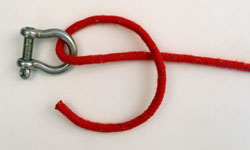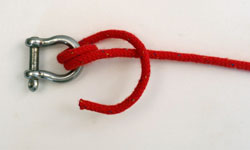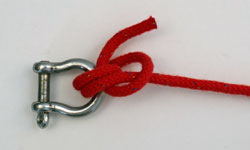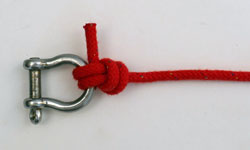- Home
- Essential Knots
- Anchor Bend
The Anchor Bend: A Step-by-Step Guide for Anchoring Safely
In a Nutshell...
The anchor bend, also known as the anchor hitch, is the preferred knot for securely attaching an anchor rode to an anchor. It’s a highly reliable knot that won't slip under load, making it a critical skill for any sailor. To tie it, you'll make two turns around the anchor's shackle, form a half hitch around the standing part, and then make a second half hitch outside of the first one. For extra security, you can finish it with a half hitch around the standing part.
Table of Contents
Few cruising sailors will use an all-rope rode tied directly to the anchor. Most will go for an all-chain or chain-to-rope rode. The connection between chain and rope will best be made with a splice or an anchor bend if a good night's sleep is to be enjoyed at anchor. That connection is the last line of defense between your boat and a rocky shore. While there are many knots to choose from, the anchor bend is the one I would choose.
Why the Anchor Bend?
The Anchor Bend Knot isn't a bend or a knot; it's a hitch. Sailors of old referred to 'bending-on an anchor' and the name of this hitch originated from those times.
It's an extremely strong and reliable hitch, much more so than the commonly used bowline or round turn and two half-hitches. Consequently, the anchor bend knot should be your first choice when making a long-term attachment to a shackle or similar item of hardware.
But why 'long-term'? Because once it's been under tension the anchor hitch can be almost impossible to undo.
Tying the Anchor Bend: A Step-by-Step Guide
Here’s how to tie this essential knot. While the steps might seem daunting at first, a few practice runs will make it second nature. For this guide, we'll assume you're using an anchor with a shackle.
- First Pass: Pass the working end of the rode through the anchor shackle.
- Two Turns: Take the working end and wrap it around the standing part of the rode twice. These turns are key to the knot's security.
- First Half Hitch: Now, pass the working end under the first two turns you just made, forming a half hitch around the standing part.
- Second Half Hitch: Bring the working end around again, creating a second half hitch outside of the first one, passing it under the turns. This effectively "locks" the knot in place.
- Dress & Tighten: Pull all parts of the knot to tighten it securely, making sure the turns are neat and flat.
- Final Security (Optional but recommended): For added security, especially in rough conditions, I recommend finishing with a third half hitch around the standing part of the line, as shown below:

Stage 1
Take a turn through the shackle.

Stage 2
Then take another one. After all one good turn deserves another!

Stage 3
Now pass the working end through both turns. If you cinch the knot up tight at this stage you should sieze the the working end to the standing part.

Stage 4
But for a super-strong and reliable connection with no need for siezing, pass the the working end through both turns a second time.
For a complete overview of knots and splicing, including their history and uses, return to our main article: A Sailor's Guide to Essential Knots & Splicing.
By Dick McClary, RYA Yachtmaster Offshore & member of the Yachting Journalists Association (YJA)
Frequently Asked Questions (FAQs)
Is the anchor bend the same as a clove hitch?
Is the anchor bend the same as a clove hitch?
No. While they both involve turns, the anchor bend is specifically designed to handle constant, heavy load and shock loading, making it far more secure for anchoring. A clove hitch can slip under constant tension.
Can I use the anchor bend for other purposes?
Can I use the anchor bend for other purposes?
Yes, the anchor bend is excellent for securing lines to a ring or post where a very strong, non-slip connection is needed.
Do I need to seize the end of the rope?
Do I need to seize the end of the rope?
For extra peace of mind, many sailors will use a seizing knot or a zip tie to secure the bitter end of the rode to the standing part. This prevents any possibility of the knot working itself loose over a long period.
What if I don't have an anchor shackle?
What if I don't have an anchor shackle?
The anchor bend can also be tied directly to the anchor's eye, though a shackle is the preferred connection point.
Sources
Recent Articles
-
Modern Boat Electronics and the Latest Marine Instruments
Dec 20, 25 05:27 PM
Should sailboat instruments be linked to the latest boat electronics as a fully integrated system, or is it best to leave them as independent units? -
Hans Christian 43: Classic Bluewater Cruiser & Liveaboard Sailboat
Dec 10, 25 04:37 AM
Explore the Hans Christian 43: a legendary heavy-displacement, long-keel sailboat. Read our in-depth review of its specs, design ratios, and suitability for offshore cruising and living aboard. -
Planning Your Sailboat Liveaboard Lifestyle: An Ocean Sailor's Guide
Dec 06, 25 05:18 AM
Seasoned sailors share their methodical risk analysis for planning a secure Sailboat Liveaboard Lifestyle, covering financial, property, and relationship risks.












